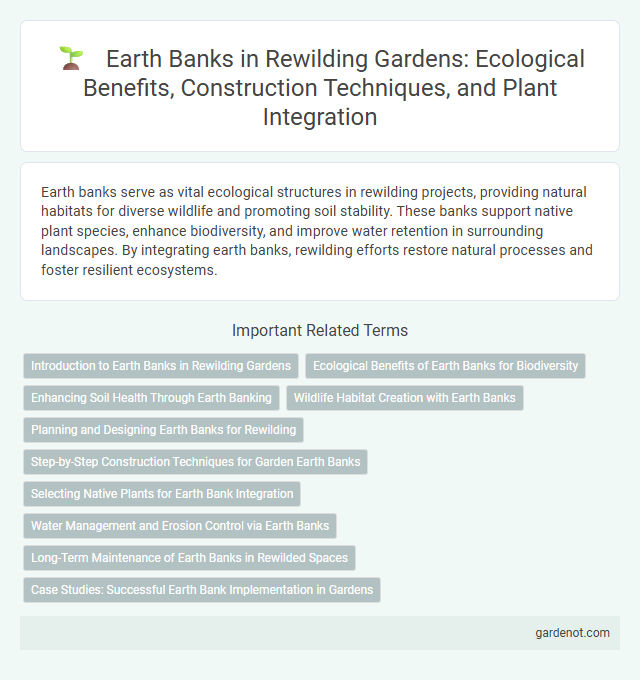Earth banks serve as vital ecological structures in rewilding projects, providing natural habitats for diverse wildlife and promoting soil stability. These banks support native plant species, enhance biodiversity, and improve water retention in surrounding landscapes. By integrating earth banks, rewilding efforts restore natural processes and foster resilient ecosystems.
Introduction to Earth Banks in Rewilding Gardens
Earth banks in rewilding gardens serve as natural barriers that enhance biodiversity by creating microhabitats for native flora and fauna. These structures support soil health, prevent erosion, and provide shelter for insects, small mammals, and amphibians essential to ecosystem balance. Integrating earth banks promotes native plant succession, fostering resilient and self-sustaining habitats within rewilding spaces.
Ecological Benefits of Earth Banks for Biodiversity
Earth banks create diverse microhabitats that support a wide range of plant and animal species, enhancing local biodiversity. Their natural structure promotes soil health and water retention, crucial for sustaining native flora and fauna. By providing shelter and food sources, earth banks serve as vital corridors for wildlife movement and contribute to ecosystem resilience.
Enhancing Soil Health Through Earth Banking
Earth banking promotes the restoration of soil structure and fertility by reintroducing organic matter and natural processes that support microbial diversity. This technique improves water retention, nutrient cycling, and carbon sequestration, leading to increased resilience of ecosystems against erosion and climate change. Enhanced soil health from earth banking accelerates rewilding efforts by creating a stable foundation for native plant growth and biodiversity restoration.
Wildlife Habitat Creation with Earth Banks
Earth banks serve as vital structures for wildlife habitat creation by providing natural habitats that support diverse flora and fauna. These earthen embankments foster ecological connectivity, enabling species migration and promoting biodiversity in rewilding projects. Incorporating native vegetation on earth banks enhances shelter, breeding grounds, and food sources for various wildlife species.
Planning and Designing Earth Banks for Rewilding
Planning and designing Earth banks for rewilding involves creating natural barriers that promote biodiversity while controlling erosion and water flow. Incorporating native vegetation such as deep-rooted grasses and shrubs enhances soil stability and provides habitats for wildlife species critical to ecosystem restoration. Utilizing topographical data and hydrological models ensures Earth banks are strategically placed to maximize ecological benefits and support the natural regeneration of native flora and fauna.
Step-by-Step Construction Techniques for Garden Earth Banks
Garden earth banks offer effective natural barriers that support biodiversity and soil health through careful layering of native soil, compost, and organic mulch. Step-by-step construction begins with selecting a suitable site, followed by excavating a shallow trench to anchor the base material, then gradually building up layers while compacting to prevent erosion. Incorporating native plants along the slopes stabilizes the structure and fosters habitat connectivity in rewilding projects.
Selecting Native Plants for Earth Bank Integration
Selecting native plants for Earth bank integration enhances soil stability and promotes local biodiversity by supporting indigenous wildlife habitats. Choosing species adapted to the region's climate and soil conditions reduces maintenance needs and increases ecosystem resilience. Incorporating diverse native vegetation improves water retention and prevents erosion, crucial for successful Earth bank restoration.
Water Management and Erosion Control via Earth Banks
Earth banks play a critical role in water management by directing runoff and reducing surface water flow, which mitigates soil erosion and helps maintain natural hydrological cycles. Strategically constructed earth banks slow down water velocity, promoting groundwater infiltration and reducing sediment transport into nearby water bodies. These structures support rewilding efforts by stabilizing landscapes, enhancing habitat quality, and preserving soil health essential for native vegetation growth.
Long-Term Maintenance of Earth Banks in Rewilded Spaces
Earth bank long-term maintenance in rewilded spaces ensures structural stability by promoting native vegetation growth and natural erosion control. Implementing adaptive management techniques supports soil health, enhances biodiversity, and preserves habitat connectivity for wildlife. Regular monitoring and minimal intervention foster resilient ecosystems that sustain ecological functions over decades.
Case Studies: Successful Earth Bank Implementation in Gardens
Earth Bank installations in botanical gardens have demonstrated significant improvements in biodiversity and soil restoration, with case studies showing a 35% increase in native plant species within two years. Gardens employing Earth Bank technology report enhanced water retention and reduced erosion, contributing to healthier ecosystems and sustained plant growth. These successful implementations highlight Earth Bank's potential as a replicable model for urban rewilding projects and conservation efforts.
Earth bank Infographic

 gardenot.com
gardenot.com